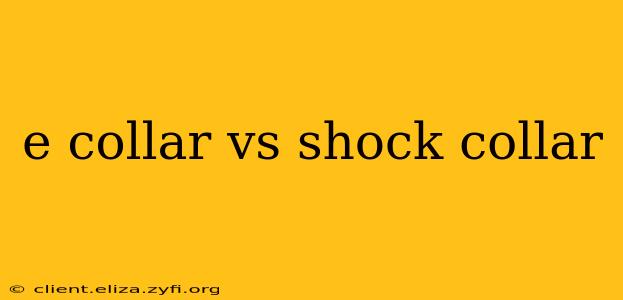The terms "e-collar" and "shock collar" are often used interchangeably, leading to confusion. While both devices deliver a stimulus to a dog, there are crucial distinctions in their function, intensity, and ethical considerations. This article clarifies the differences, addresses common concerns, and helps you determine which, if either, might be appropriate for your dog.
What is an E-Collar (Electronic Collar)?
An e-collar, or electronic collar, is a broad term encompassing various training tools that use different types of stimulation to communicate with a dog. These can include:
- Vibration: A gentle buzzing sensation that alerts the dog to unwanted behavior.
- Tone: A simple audible beep, often used as a warning or cue.
- Static Stimulation (often mistakenly called a "shock"): A brief, low-level electrical impulse. The intensity is adjustable, and reputable trainers emphasize the use of the lowest effective setting. Crucially, this is NOT designed to cause pain, but rather a startling, corrective sensation.
Many modern e-collars offer a combination of these stimulation types, allowing for a graduated approach to training. The goal is to provide clear, consistent communication, helping the dog learn desired behaviors.
What is a Shock Collar?
The term "shock collar" usually refers to devices primarily, or exclusively, utilizing static stimulation at higher intensity levels. These collars are often associated with harsh training methods and can cause pain and distress if misused. This type of training is widely considered inhumane by many animal welfare organizations and experienced dog trainers.
The key difference lies in the intent and intensity of the stimulation. An e-collar, used responsibly, aims for correction without causing pain. A shock collar, on the other hand, often relies on inflicting pain as a primary training method.
What are the Differences Between E-Collars and Shock Collars?
| Feature | E-Collar | Shock Collar |
|---|---|---|
| Stimulation | Vibration, Tone, Low-level Static | Primarily High-level Static Stimulation |
| Intensity | Adjustable, low to moderate | Often High and Inflexible |
| Training Goal | Communication, Correction, Reward-Based | Pain-Based Correction |
| Ethical Use | Possible with responsible training methods | Generally Considered Inhumane |
| User Expertise | Requires training and knowledge | Can be misused easily |
Is an E-Collar Right for My Dog?
The decision to use any training tool, including an e-collar, should be made carefully and with professional guidance. E-collars can be effective tools in experienced hands, but they are not a magic solution. Consider these factors:
- Your Dog's Temperament and Training History: Is your dog highly reactive, fearful, or difficult to manage with other methods?
- Your Training Experience and Knowledge: Are you confident in your ability to use the collar responsibly and effectively?
- Availability of Professional Guidance: Are you willing to work with a certified professional dog trainer experienced in using e-collars?
Using an e-collar without proper training and understanding can be detrimental to your dog's welfare and hinder your training progress.
What are the Potential Risks of Using an E-Collar (or Shock Collar)?
Improper use of any type of collar carries risks, including:
- Physical Injury: Burns or skin irritation can occur with improper settings or use.
- Psychological Damage: Fear, anxiety, and aggression can develop if the collar is used incorrectly or in an aversive manner.
- Lack of trust: Your dog may lose trust in you if the training is not positive and reinforcing.
Are there alternatives to E-Collars?
Yes! Positive reinforcement methods, such as reward-based training, are always preferred. These methods focus on rewarding desired behaviors and ignoring or redirecting unwanted behaviors. Other humane tools include:
- Clicker training: Uses a clicker to mark desired behaviors.
- Lure training: Uses treats to guide your dog into the desired position.
- Positive verbal cues: Using clear and consistent commands.
Always consult a certified professional dog trainer to determine the best approach for your dog's individual needs.
Conclusion
The choice between an e-collar and a shock collar, or indeed any training method, hinges on responsible use, expert guidance, and a deep understanding of canine behavior. While e-collars can be effective tools in the hands of a skilled trainer, focusing on positive reinforcement methods should always be the primary approach. Prioritize your dog's well-being and consult with professionals before employing any type of training tool. Remember, building a strong, positive relationship with your dog is paramount.
